“Most of the blokes here are a sausage short of the barbecue, at the very least,” Russell Crowe says to Anthony Hopkins as he gazes around a moccasin factory.
In the 1992 film, Spotswood, Hopkins portrays an eagle-eyed efficiency expert, tasked with whipping the carefree employees into shape to save the factory. Crowe is the self-interested upstart trying to gain a foothold in the business.
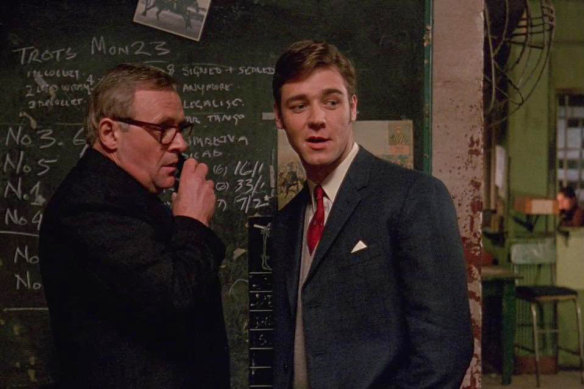
Anthony Hopkins (left) and Russell Crowe starred in the 1992 movie Spotswood<./>.
The characters and the factory may be fictional, but the titular suburb is very real. Tucked away in the shadow of the West Gate Bridge in Melbourne’s inner west, it is somewhat unassuming.
If you search for “Spotswood” on the Australian Bureau of Statistics website, it will politely ask: “Did you mean softwood?”
Once the data is located, it is perhaps clear why – just 2820 people call the suburb home, according to the latest census.
But for a tiny locale, there’s a bit going on.
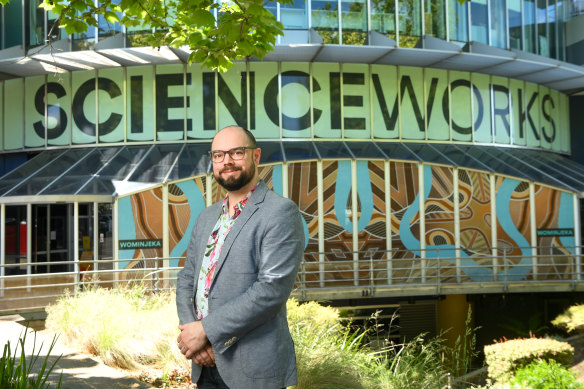
Scienceworks general manager Jonathan Shearer said the museum had expanded to include the famous planetarium and lightning room.Credit: Justin McManus
Science and technology museum Scienceworks has been a fixture of the suburb since 1992. The museum’s location was chosen for the historic steam-powered sewage-pumping station on site, general manager Jonathan Shearer said.
“[The] pumping station was seen as the innovation of its day back in the 1890s when it was opened. The idea was there’d be a modern science museum to complement the heritage building at the other end of site,” he said.
Shearer said the pumping station was an important feature in the modernisation of Melbourne’s sewage system, which had up until then involved throwing human waste into the streets.
“Melbourne was primarily a gold rush city and so in a very short period of time, with a very large amount of money that had come from gold mining, they built a lot of the civic buildings in the CBD area,” he said.
“But they built the city with no sewage system under it. And so even though we had this fancy, beautiful city, people were tipping waste into the rivers or tipping waste out into the street, and we were being parodied apparently in newspapers as “Smellbourne” because we had no sewer system.”
He said a system was retroactively installed under Melbourne 30 years later.
“Using 19th century technology, they tunnelled all the way from the CBD, under the mudflats, under the Yarra, to come up in Spotswood,” he said.
“It was this hugely ambitious project to make up for a major mistake.”
He said Spotswood was still known for its industries, with the small suburb split between industrial land, much of which is now vacant, and residential.
“The locals are really proud of that industrial heritage, and I think Scienceworks really plays into that,” he said.
For the Spotswood movie creators, the industrial setting served as a time machine of sorts, as the 1992 film – which features a young Toni Collette and Ben Mendelsohn racing their bikes through the quiet streets – was set in 1966.
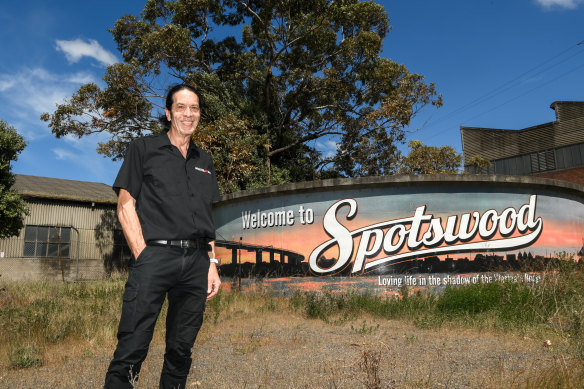
Tony Mead’s artwork has been inspired by Spotswood’s industrial past. Credit: Justin McManus
Much of that ageing infrastructure remains a feature of the landscape, and local signwriter Tony Mead said it had inspired his work, including the “Welcome to Spotswood” sign painted on an old water tank.
“As things become gentrified and more residential, I think it’s important for people to remember their industrial heritage. And you know, don’t be ashamed of it, but embrace it as part of what created the area in the first place,” he said.
Mead said he moved his factory to Spotswood 25 years ago, and the area had changed a lot since then.
“When I came here, you couldn’t get a coffee for love nor money,” he said.
“There’s definitely a lot more cafes, a lot more childcare centres... It’s become a lot more friendly to new residents.”
Mead said one of the biggest challenges for residents had been frequent road works, limiting accessibility to the city.
“The only thing that’s been bad has been the West Gate Freeway works, which have been going on for a long time, and it really affected the area,” he said. “It’s just been very disruptive... We’ve had a lot of road closures and inability to access it at certain points.”
When those roadworks wreak havoc, one of the quickest ways across the river is the Westgate Punt – a small, bright red passenger ferry that reliably chugs across the river come rain, hail or shine.
Skipper David Neil said he often transported city workers – on anything from bikes to roller skates – to and from Spotswood. Though some passengers kept to themselves at first, after a few months of taking the trip, they and Neil would get to know each other.
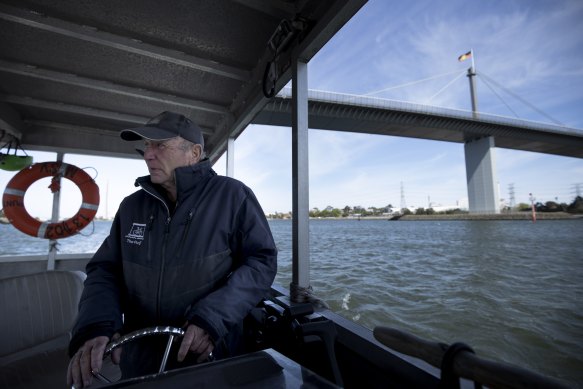
Skipper David Neil rises at the crack of dawn to ferry passengers across the Yarra. Credit: Arsineh Houspian
“I’m like a psychologist or marriage therapist,” he joked.
The Age joined Neil on the punt as he ferried passengers from Spotswood to Port Melbourne – something he has been doing for 10 years.
The trip took only about five minutes as the wind whipped around, trying to blow the little ferry off course. On its return approach to Spotswood, the red-brick pumping station was in clear view.
Neil said if one had a good imagination, the scene could be from some exotic destination.
“See the old colonial building, the palm trees, the rotunda. Where could you be coming into? Somewhere in the Bahamas?” he said.
Former resident Jim Hevey grew up in Spotswood and said everything he needed had been a short walk away, including school, two milk bars, a butchers shop and the Methodist Church, which he and his friends joined because it had a cricket side.
“It was like a village, and to a certain extent, still remains a village,” he said.
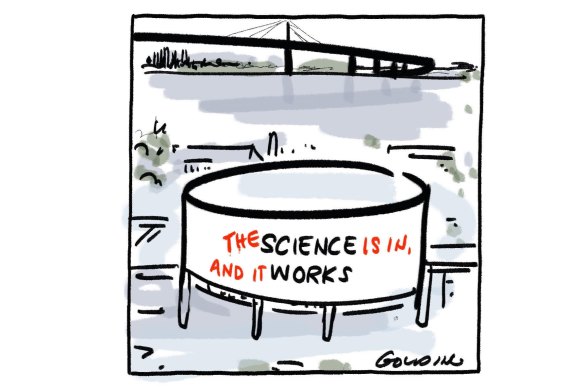
Credit: Matt Golding
He said the industry and working class culture in Spotswood and the surrounding suburbs led to the area being referred to as the next Birmingham.
“A lot of the street names are named after English railway engineers; Stephenson and Watt and Vernon... Hudsons Road was named after the Hudson Brothers NSW Railways.”
When European settlers arrived in the area, they displaced the Indigenous peoples of the Bunurong (Boon Wurrung) and Woi Wurrung (Wurundjeri) tribes, part of the Kulin nation.
Hevey, who moved out of the suburb when he was 25, maintains an interest in the local history, which he said was first sparked by the unique spelling of the suburb name emblazoned across the entrance of the local pub.
“What intrigued me growing up as a kid was that the hotel was called the Spottiswoode Hotel,” he said.
Now a member of the Altona Laverton Historical Society, Hevey has researched the origins of the suburb, which was named after one of the early Melbourne settlers, John Spotswood.
But Hevey said a mix-up occurred when Spotswood obtained some local land and his name was recorded incorrectly as the old Scottish spelling, Spottiswoode.
Because parts of the town, including the train station and the post office, already had the wrong spelling when the hotel was built in 1888, the family stuck with it, Hevey said.
“At the time the hotel was built, George, who was John Spotswood’s son, was just thinking, well, no one will find the hotel if I call it by the family name,” he said.
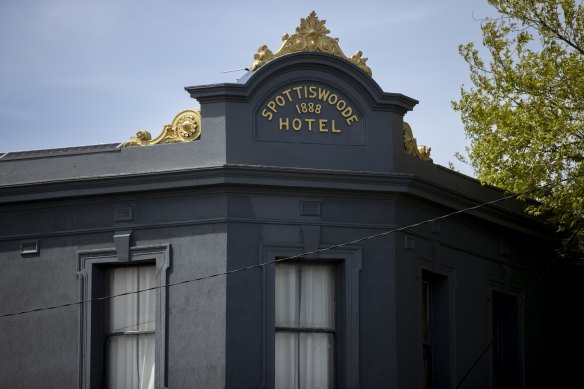
The suburb’s namesake, John Spotswood, had his name spelled incorrectly when he first purchased land.Credit: Arsineh Houspian
“I’d like to hear John Spotswood speak, what his pronunciation was, having been brought up in Mumbai and Britain and then coming out and trying to spell his name while he’s buying a block of land. That’s probably how it ended up as Spottiswoode.”
The correct spelling was made official in 1905, but the original signage on the hotel remains.
The watering hole has gone through many changes since those days and is now a renovated, family-friendly pub.
But signwriter Tony Mead recalls a different era, when he moved his factory out of Richmond to the west hoping to experience a quieter part of town.
“Spotswood, when I first moved here, was quite rough still,” he said.
“I came out one Sunday about 20 years ago... because I could hear a lot of noise in the street.”
“It ended up being a riot at the Spotswood Hotel, which was at the time a topless bar, and the bikies were there and the police were there and helicopters were there, and I just turned around, went back to my factory,” he laughed.
Mead said one of his favourite things about the suburb today was driving down the main shopping strip, Hudsons Road, and seeing a huge ship come into vision as it floated down the Yarra.
“The whole horizon gets blocked out by a ship passing through, which is not like any other suburb I’ve seen,” he said.
“We like the scale of things around here, the bigness of things.”
The biggest thing in Spotswood is arguably the West Gate Bridge, which looms large over the suburb – not just because of its physical presence, but also because of its tragic history.
It was 1970 when disaster struck the ambitious project to better connect Melbourne’s west to the city, and the near-complete bridge collapsed, killing 35 workers.
Nine News reported at the time that 2000 tonnes of concrete and steel fell into the river. Injured men had to be restrained from going back into the water to search for their colleagues.
It remains Australia’s worst industrial accident. A memorial to the 35 men, erected by their workmates, sits under the bridge at the place of the collapse.
Today, the view of the bridge is a defining feature of the suburb, and one of the best spots to see it is from culinary destination Grazeland.
Director John Forman said the site, packed with shipping containers fitted serving a variety of cuisines, was chosen for its views.
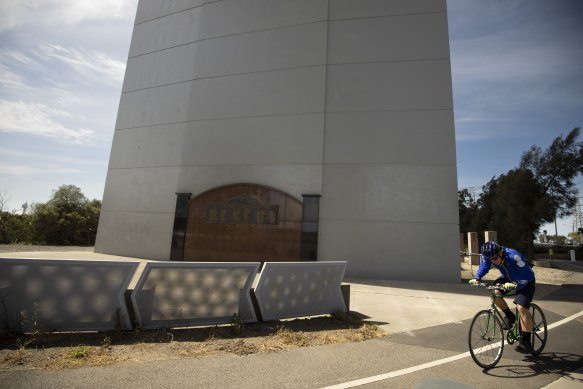
A memorial marks the spot where the West Gate Bridge collapsed on October 15, 1970.Credit: Arsineh Houspian
“We thought Spotswood was a perfect position overlooking our great city with the great views from the west, so it has a really Brooklyn feel about it,” he said.
“It’s definitely a happening area... And I think hopefully we’ve added to a bit of that feeling.”
He said he had wanted to establish a major food destination in Melbourne, and there had been a gap in offerings in the western suburbs.
“It’s a very big growth corridor for Melbourne,” he said. “There’s a lot of couples and families come into the area.”
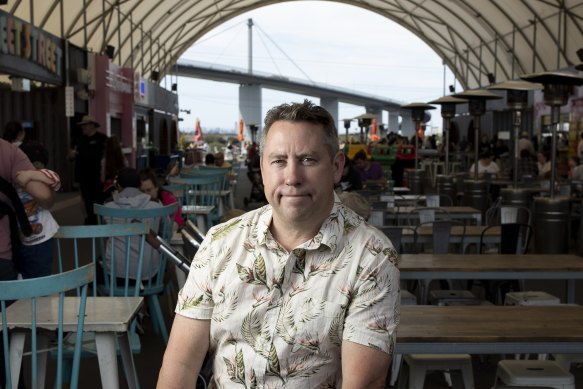
Director John Forman describes Grazeland as a “foodie mecca”.Credit: Arsineh Houspian
According to the latest ABS data, families occupy most of the homes in Spotswood.
The median mortgage repayment of $2300 per month is higher than the Victorian median of $1859, although it is less than in neighbouring Williamstown and Yarraville.
Most of the locals were born in Australia, followed by England, New Zealand and India, and the languages other than English most commonly used at home are Greek, Italian and Croatian.
Residents are also employed at a higher rate than the state average, and although the Spotswood movie casts the hardworking locals as well-meaning but simple, real Spotswood residents today are highly educated, with 41.4 per cent holding a bachelor’s degree or higher compared with the state average of 29.2 per cent.
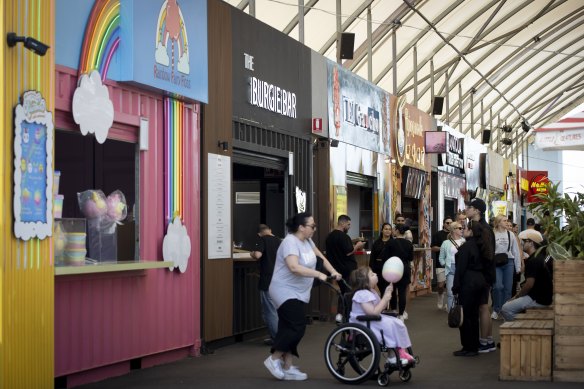
Crowds at Grazeland this month.Credit: Arsineh Houspian
The most common industries of employment are hospitals, primary education and computer system design.
Things have certainly changed since the days Anthony Hopkins drove around the suburbs asking locals for directions to the struggling moccasin factory.
Start the day with a summary of the day’s most important and interesting stories, analysis and insights. Sign up for our Morning Edition newsletter.